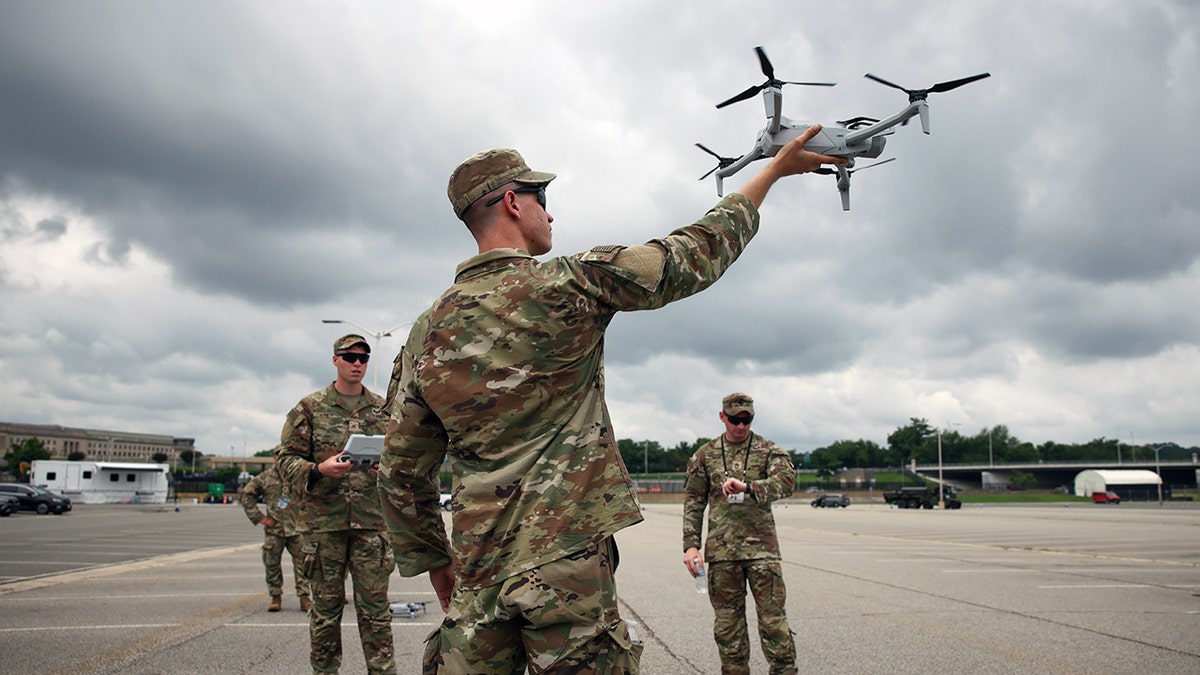NEWYou can now listen to Fox News articles!
The Army is expanding its use of artificial intelligence beyond drones — from wearable smart glasses that train mechanics in the field to automated defenses against swarms of cheap enemy aircraft — as leaders warn the counter-drone fight is now “problem 1A” for the nation.
Speaking to reporters this week, Army Secretary Dan Driscoll described a pilot program in which soldiers wearAI-enabled Ray-Ban glasses that record repair jobs and then use generative models to walk less-experienced troops through infantry squad vehicle maintenance. He said it reflects a new push to bring consumer technology into the force “a lot more quickly” than in the past. While Meta may have spent billions developing the glasses, the Army is testing them for about $400 a pair.
Gen. Randy George, the Army’s chief of staff, said the same approach applies to the Pentagon’s top emerging challenge: defending against drones.
“This is problem 1A that we’re facing as a country,” Driscoll said, stressing that counter-drone technology must be cheap, fast and automated. “If you think of a drone swarm … it is a nearly impossible idea for even human beings [to handle].”
AI ARMS RACE: US AND CHINA WEAPONIZE DRONES, CODE AND BIOTECH FOR THE NEXT GREAT WAR
That challenge has been underscored overseas, where advanced aircraft have been used to intercept relatively inexpensive drones. “If you’ve got a $5,000 drone, you want a $2,000 or $3,000 or $4,000 interceptor, and that’s what we’re focused on,” George said.
Last week, Dutch F-35s and Polish F-16s deployed to take out dozens of Russian drones flying into Russian territory.
George added that the Army is testing proximity rounds and high-energy lasers, while the bigger hurdle is defending against drones in crowded civilian airspace.
As part of the Army’s “continuous transformation” initiative, George said 25 brigades will be overhauled in the next two years to make them more lethal, mobile and survivable in high-threat environments. The first armored brigade combat teams are set to rotate through the National Training Center in California this November, followed by a large-scale exercise in Hawaii.
George also pointed to armor modernization, saying the Army’s next-generation M1E3 tank — envisioned as a lighter, faster replacement for the Abrams — could reach units as early as next year. That would mark a major acceleration, since earlier projections suggested the vehicle would not field until the 2030s.
To pay for its modernization drive, Driscoll said the Army plans to cut $48 billion over five years from programs it no longer needs, reinvesting in drones, air defenses and long-range fires.
PENTAGON UNVEILS $961B BUDGET REQUEST: FUND FOR GOLDEN DOME, MISSILES AND DRONES, FEWER F-35 JETS

The service also launched a $750 million “Fuse” fund to support small and mid-sized businesses and previewed new acquisition reforms to be detailed at next month’s AUSA conference. Modeled partly on the rapid iteration practices of commercial companies, the changes will co-locate soldiers, engineers and contractors to speed up design and fielding.
Officials also highlighted in-house efforts. George said the Army is now building its own drones at depots with all-American parts — including models already flying in Ukraine — to help replenish stockpiles. Driscoll said 3D printing is being tested as a way to overcome the “tyranny of distance” in the Indo-Pacific, allowing soldiers to fabricate parts in theater instead of waiting on long supply lines.
George pointed to battlefield command as another area of change. The 4th Infantry Division is now testing command-and-control apps on ruggedized tablets — replacing the trucks and racks of radios that have long anchored Army command posts.
The move is designed to make headquarters smaller and harder to target, though outside experts have warned that relying on commercial-style devices could introduce new cyber vulnerabilities and durability issues in combat.
Driscoll also credited President Trump with backing the Army’s overhaul. “They’ve held the line every single time when we have made a hard decision,” he said. Still, he acknowledged that each of the $48 billion in cuts has defenders in Congress and industry.
Read the full article here


